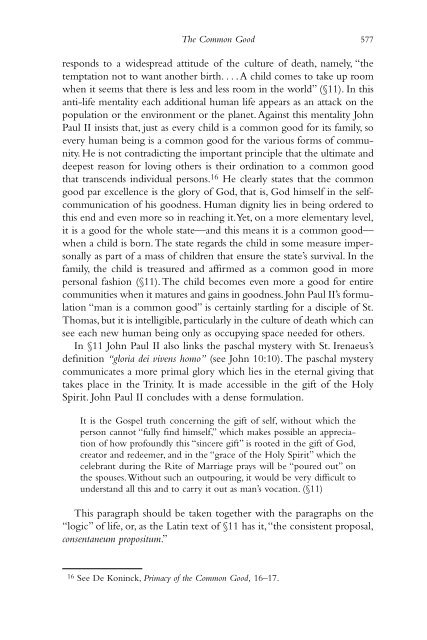The Common Good in St. Thomas and John Paul II WHEN
The Common Good in St. Thomas and John Paul II WHEN
The Common Good in St. Thomas and John Paul II WHEN
Create successful ePaper yourself
Turn your PDF publications into a flip-book with our unique Google optimized e-Paper software.
<strong>The</strong> <strong>Common</strong> <strong>Good</strong> 577<br />
responds to a widespread attitude of the culture of death, namely, “the<br />
temptation not to want another birth. . . .A child comes to take up room<br />
when it seems that there is less <strong>and</strong> less room <strong>in</strong> the world” (§11). In this<br />
anti-life mentality each additional human life appears as an attack on the<br />
population or the environment or the planet. Aga<strong>in</strong>st this mentality <strong>John</strong><br />
<strong>Paul</strong> <strong>II</strong> <strong>in</strong>sists that, just as every child is a common good for its family, so<br />
every human be<strong>in</strong>g is a common good for the various forms of community.<br />
He is not contradict<strong>in</strong>g the important pr<strong>in</strong>ciple that the ultimate <strong>and</strong><br />
deepest reason for lov<strong>in</strong>g others is their ord<strong>in</strong>ation to a common good<br />
that transcends <strong>in</strong>dividual persons. 16 He clearly states that the common<br />
good par excellence is the glory of God, that is, God himself <strong>in</strong> the selfcommunication<br />
of his goodness. Human dignity lies <strong>in</strong> be<strong>in</strong>g ordered to<br />
this end <strong>and</strong> even more so <strong>in</strong> reach<strong>in</strong>g it.Yet, on a more elementary level,<br />
it is a good for the whole state—<strong>and</strong> this means it is a common good—<br />
when a child is born.<strong>The</strong> state regards the child <strong>in</strong> some measure impersonally<br />
as part of a mass of children that ensure the state’s survival. In the<br />
family, the child is treasured <strong>and</strong> affirmed as a common good <strong>in</strong> more<br />
personal fashion (§11). <strong>The</strong> child becomes even more a good for entire<br />
communities when it matures <strong>and</strong> ga<strong>in</strong>s <strong>in</strong> goodness. <strong>John</strong> <strong>Paul</strong> <strong>II</strong>’s formulation<br />
“man is a common good” is certa<strong>in</strong>ly startl<strong>in</strong>g for a disciple of <strong>St</strong>.<br />
<strong>Thomas</strong>, but it is <strong>in</strong>telligible, particularly <strong>in</strong> the culture of death which can<br />
see each new human be<strong>in</strong>g only as occupy<strong>in</strong>g space needed for others.<br />
In §11 <strong>John</strong> <strong>Paul</strong> <strong>II</strong> also l<strong>in</strong>ks the paschal mystery with <strong>St</strong>. Irenaeus’s<br />
def<strong>in</strong>ition “gloria dei vivens homo” (see <strong>John</strong> 10:10). <strong>The</strong> paschal mystery<br />
communicates a more primal glory which lies <strong>in</strong> the eternal giv<strong>in</strong>g that<br />
takes place <strong>in</strong> the Tr<strong>in</strong>ity. It is made accessible <strong>in</strong> the gift of the Holy<br />
Spirit. <strong>John</strong> <strong>Paul</strong> <strong>II</strong> concludes with a dense formulation.<br />
It is the Gospel truth concern<strong>in</strong>g the gift of self, without which the<br />
person cannot “fully f<strong>in</strong>d himself,” which makes possible an appreciation<br />
of how profoundly this “s<strong>in</strong>cere gift” is rooted <strong>in</strong> the gift of God,<br />
creator <strong>and</strong> redeemer, <strong>and</strong> <strong>in</strong> the “grace of the Holy Spirit” which the<br />
celebrant dur<strong>in</strong>g the Rite of Marriage prays will be “poured out” on<br />
the spouses.Without such an outpour<strong>in</strong>g, it would be very difficult to<br />
underst<strong>and</strong> all this <strong>and</strong> to carry it out as man’s vocation. (§11)<br />
This paragraph should be taken together with the paragraphs on the<br />
“logic” of life, or, as the Lat<strong>in</strong> text of §11 has it,“the consistent proposal,<br />
consentaneum propositum.”<br />
16 See De Kon<strong>in</strong>ck, Primacy of the <strong>Common</strong> <strong>Good</strong>, 16–17.


